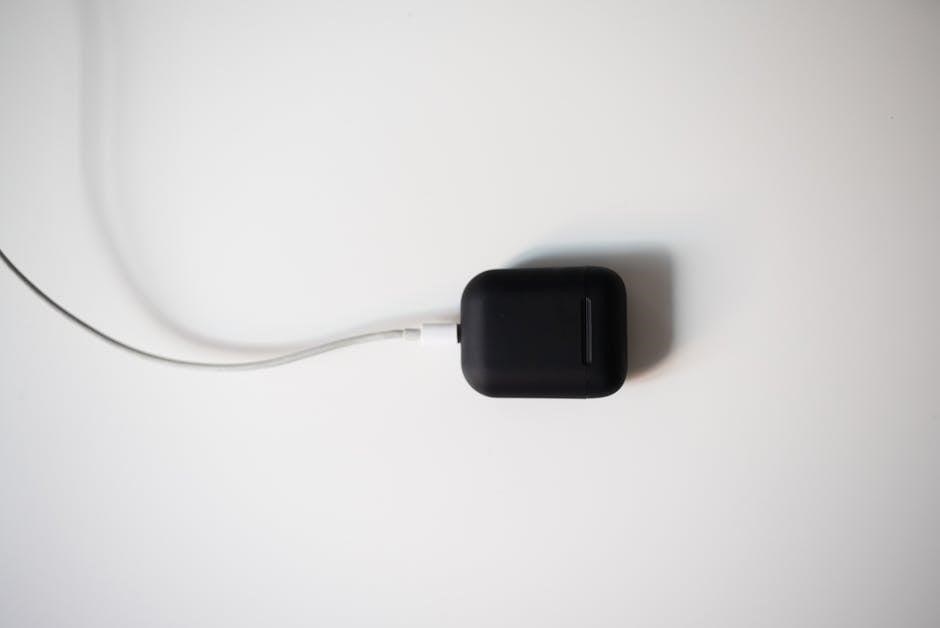Choosing the right battery cable size is crucial for ensuring reliability and performance. Factors like current draw and cable length influence the required gauge. Using a wire gauge chart helps select the correct size, avoiding issues like voltage drop or overheating.
Battery cables are essential components in electrical systems, connecting batteries to devices, inverters, or other electrical components. They play a critical role in ensuring reliable power delivery, especially in vehicles, solar systems, and industrial applications. Typically made from durable materials like copper or aluminum, these cables are designed to handle high currents and withstand harsh environments. Proper sizing and installation of battery cables are vital to prevent issues such as voltage drop, overheating, and system inefficiency.
Battery cables come in various sizes, ranging from 10 AWG to 4/0 AWG, with larger gauges accommodating higher currents; The choice of cable size depends on factors like the system’s current requirements, cable length, and operating conditions. Using the wrong size can lead to suboptimal performance or even safety hazards. This guide provides a comprehensive overview of battery cable sizing, helping users select the right cables for their specific needs. By understanding the fundamentals of battery cables and their sizing principles, you can ensure efficient, safe, and reliable electrical connections in your system.
Understanding Wire Gauge Systems
The wire gauge system, specifically the American Wire Gauge (AWG), is crucial for determining the appropriate thickness of battery cables. A lower gauge number indicates a thicker wire, capable of handling higher currents without overheating, which is essential for high-current applications.
The AWG system is non-linear, meaning the difference between consecutive gauges is significant in terms of wire diameter and current-carrying capacity. This careful calibration ensures each gauge is suited for specific current levels, vital for safe and efficient electrical systems.
Battery cables typically range from 10 AWG to 4/0 AWG, catering to various power requirements. While 10 AWG may suffice for smaller applications, 4/0 AWG is reserved for heavy-duty uses where substantial power is necessary.
Standard tables map each gauge to its diameter and ampacity, aiding in matching the wire to the system’s electrical demands. Material differences, such as copper versus aluminum, affect conductivity and current-carrying capacity due to varying resistivities.
Cable length also plays a role, as longer cables introduce more resistance and potential voltage drop. Thus, selecting the right gauge involves balancing current requirements with cable length to ensure efficiency and safety.

Factors Influencing Cable Size
Several critical factors influence the selection of the appropriate battery cable size. First and foremost, the current draw of the system is a primary determinant. Higher current requirements necessitate thicker cables to prevent overheating and potential fire hazards. Cable length also plays a significant role, as longer cables increase resistance, leading to voltage drop. To maintain efficiency, the cable must be sized to compensate for this loss.
The operating voltage and environmental conditions further affect cable size. High-voltage systems may require specialized insulation to prevent arcing and ensure safety. Additionally, environmental factors such as temperature extremes, moisture, and exposure to chemicals can impact the cable’s durability and performance, necessitating appropriate sizing and material selection.
Application-specific standards also guide cable sizing. For instance, marine and automotive applications often have distinct requirements due to varying power demands and operating conditions. Understanding these factors ensures that the chosen cable is both safe and effective for its intended use.
Battery Cable Size Charts
Battery cable size charts are essential tools for determining the appropriate wire gauge for specific applications. These charts typically list cable sizes ranging from 10 AWG to 4/0 AWG, providing details such as the cable’s diameter, current-carrying capacity, and maximum voltage drop.
By referencing these charts, users can identify the correct cable size based on their system’s current requirements and cable length. For example, a 10 AWG cable might be suitable for smaller systems with shorter runs, while a 4/0 AWG cable is better for high-current applications or longer distances.
The charts also account for factors like resistance and voltage drop, ensuring efficient power delivery. Proper use of these charts helps prevent issues such as overheating, power loss, and system malfunction. They are widely available online and are often included in product specifications or installation guides.
Calculating the Correct Cable Size
To calculate the correct battery cable size, consider the system’s current, voltage, and cable length. The goal is to minimize voltage drop while ensuring the cable can handle the maximum current safely.
Start by determining the total current draw of your system. Next, measure the round-trip distance of the cable (from the battery to the device and back). Use an online wire size calculator or refer to an AWG chart to find the appropriate gauge based on these values.
Voltage drop should not exceed 3% for optimal performance. If the calculated gauge is unavailable, choose the next larger size. Always consider factors like temperature and the environment, as they can affect the cable’s rating.

Common Mistakes to Avoid
When selecting battery cables, several common mistakes can lead to inefficiency or safety hazards. One of the most frequent errors is using a cable that is too small for the current requirements, which can cause overheating and voltage drop. Many people also overlook the importance of voltage drop calculations, assuming any cable will work as long as it fits physically.
Another mistake is not considering the environmental conditions, such as temperature fluctuations or exposure to moisture, which can degrade the cable over time. Some individuals miscalculate the total cable length, forgetting to account for the round-trip distance between the battery and the device. Additionally, relying solely on wire size charts without understanding the underlying principles can lead to incorrect choices.
Finally, safety oversights, such as using cables with inadequate insulation or ignoring the need for proper terminals, can result in dangerous electrical issues. Avoiding these mistakes ensures reliable performance and safety in your electrical system.

Types of Battery Cables
Battery cables are available in various types, each designed for specific applications and performance needs. The most common types include standard copper core cables, which are durable and cost-effective, and high-performance cables made from premium materials like tinned copper for better corrosion resistance.
Flexible battery cables are ideal for installations where movement or vibration is expected, as they are designed to withstand bending and twisting. Marine-grade cables are another specialized type, built to resist moisture and saltwater exposure, making them suitable for boats and watercraft.
Heavy-duty cables, such as those rated for 4/0 AWG or larger, are used in high-current applications like industrial equipment or large vehicle systems. Additionally, there are cables with insulation rated for extreme temperatures, ensuring reliability in harsh environments.
Understanding the differences in materials, flexibility, and environmental ratings helps in selecting the right cable for your specific needs, ensuring safe and efficient electrical connections.
Safety Considerations
Safety is paramount when working with battery cables. Proper sizing ensures cables can handle the current without overheating, which can cause fires or damage. Always use cables rated for the intended current and voltage to avoid potential hazards.
Inspect cables regularly for signs of wear, such as fraying or corrosion, and replace them immediately if damage is found. Secure connections tightly to prevent loose contacts, which can lead to arcing or overheating. Use high-quality insulation to prevent short circuits and ensure cables are protected from environmental factors like moisture or extreme temperatures.
When handling batteries, wear protective gear, including gloves and safety goggles, to protect against acid spills or electrical sparks. Avoid overloading cables, as this can lead to failure. Follow local electrical codes and guidelines for installations to ensure compliance and safety.

Regular maintenance and inspections are critical to maintaining safe and reliable battery cable performance. Addressing issues early prevents accidents and ensures optimal system operation.
Tools and Resources
To ensure accurate battery cable sizing and safe installation, several tools and resources are essential. A wire gauge chart is a fundamental tool, helping determine the appropriate cable size based on current and length. Online battery cable size calculators simplify the process by providing instant recommendations.
A multimeter is crucial for measuring voltage, current, and resistance, ensuring the system operates within safe parameters. Crimping tools are necessary for securing connectors to cables, while insulation testers verify the integrity of the cable’s insulation.
Additional resources include wire sizing guides and voltage drop calculators, which help account for energy loss over distance. Online forums and tutorials provide practical advice and troubleshooting tips. Always refer to manufacturer specifications and safety guidelines for reliable results.
Investing in quality tools and utilizing reputable resources ensures proper cable installation, enhancing system performance and safety. Regularly update your knowledge and tools to keep up with evolving standards and technologies.
Choosing the right battery cable size is essential for ensuring safety, performance, and reliability in any electrical system; Proper sizing prevents issues like voltage drop, overheating, and system malfunctions. By understanding factors such as current, voltage, and cable length, and using tools like wire gauge charts and calculators, you can make informed decisions. Avoid common mistakes like undersizing cables, as this can lead to inefficiency or even hazards. Familiarize yourself with cable types and always adhere to safety guidelines to prevent electrical risks. With the knowledge from this guide, you can confidently select and install the correct battery cables, ensuring your system operates efficiently and securely.
